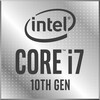Intel Core i7-1060G7 vs Apple M3 Max 14-Core vs Intel Core i7-1060NG7
Intel Core i7-1060G7
► remove from comparison
The Intel Core i7-1060G7 is a power efficient quad-core SoC for laptops and Ultrabooks based on the Ice -Lake-Y generation that was announced in Mai 2019 (Computex). It integrates four Sunnycove processor cores (8 threads thanks to HyperThreading) clocked at 1 (base) - 3.8 (single core Turbo) GHz. All four cores can turbo up to 3.4 GHz using Turbo Boost. According to Intel the Sunnycove cores achieve 18% more IPCs (Instructions per Clock).
Combined with the two additional cores, the previous Y-series dual core processors (Amber Lake-Y) should be always slower. Short burst performance should be excellent, long workloads will depend on the TDP settings and cooling solution in the laptop / tablet.´
The biggest improvement for Ice-Lake is the integrated Gen 11 graphics card called Iris Plus Graphics. The Core i7-1060G7 integrates the biggest G7 variant with 64 CUs clocked at 300 - 1100 MHz. The Iris Plus G7 should be twice as fast as the predecessors and best the AMD Vega 10 GPU in current Ryzen APUs. However, in the Y-series the gaming performance will be again depending on the cooling solution and may degrade clearly over time (compared to the Core i7-1065G7 with 15 - 25 Watt e.g.).
Other improvements for Ice Lake are the AI hardware acceleration and the partial integration of Thunderbolt and Wifi 6 in the chip. The integrated DDR4 memory controller supports modules with up to 3200 MHz (and LPDDDR4 3733).
The Core i7-1060G7 is produced in the new 10nm process at Intel (2nd generation) that should offer a comparable performance to the 7nm process at TSMC. The TDP is specified at 9 Watts and therefore the CPU can be used in thin and light laptops. Intel offers a configurable TDP of up to 12 Watts for the partners resulting in significant performance differences (due to longer periods of Turbo Boost).
Apple M3 Max 14-Core
► remove from comparison
The Apple M3 Max 14 core CPU is a system on a chip (SoC) from Apple for notebooks that was introduced towards the end of 2023. It integrates a new 14-core CPU with 10 performance cores with up to 4.06 GHz and 4 efficiency cores with 2.8 GHz. There is also a more powerful 16-core variant with 40 GPU cores.
Thanks to the higher clock rates and architectural improvements, the processor performance is also significantly better than the M2 Max in benchmarks and can keep up with the fastest mobile CPUs.
The M3 also integrates a new graphics card with dynamic caching, mesh shading and ray tracing acceleration via hardware. In the cheaper model, 30 of the chip's 40 cores are used and support up to 5 displays simultaneously (internal and 4 external).
GPU and CPU can jointly access the shared memory on the package (unified memory). This is available in 36 and 96 GB variants and offers 400 GB/s maximum bandwidth (512 bit bus).
The integrated 16-core Neural Engine has also been revised and now offers 18 TOPS peak performance (compared to 15.8 TOPS in the M2 but 35 TOPS in the new A17 Pro). The video engine now also supports AV1 decoding in hardware. H.264, HEVC and ProRes (RAW) can still be decoded and encoded. Like its predecessor, the Max chip offers two video engines and can therefore encode and decode two streams simultaneously.
Unfortunately, the integrated WLAN only continues to support WiFi 6E (no WiFi 7), unlike the small M3 SoC thunderbolt 4 is also supported (max 40 Gbit/s).
The chip is manufactured in the current 3nm process (N3B) at TSMC and contains 92 billion transistors (+37% vs. Apple M2 Max).
Intel Core i7-1060NG7
► remove from comparison
The Intel Core i7-1060NG7 is a power efficient quad-core SoC for laptops and Ultrabooks based on the Ice -Lake-Y generation that was announced in Mai 2019 (Computex). It integrates four Sunnycove processor cores (8 threads thanks to HyperThreading) clocked at 1.2 (base) - 3.8 (single core Turbo) GHz. All four cores can turbo up to 3.4 GHz using Turbo Boost. According to Intel the Sunnycove cores achieve 18% more IPCs (Instructions per Clock).
Compared to the normal Core i7-1060G7, the i7-1060NG7 offers a smaller package size (22 x 16.5 versus 26.5 x 18.5 mm), a higher base clock of 1200 versus 1000 MHz and a 1 Watt higher TDP.
Combined with the two additional cores, the previous Y-series dual core processors (Amber Lake-Y) should be always slower. Short burst performance should be excellent, long workloads will depend on the TDP settings and cooling solution in the laptop / tablet.´
The biggest improvement for Ice-Lake is the integrated Gen 11 graphics card called Iris Plus Graphics. The Core i7-1060NG7 integrates the biggest G7 variant with 64 CUs clocked at 300 - 1100 MHz. The Iris Plus G7 should be twice as fast as the predecessors and best the AMD Vega 10 GPU in current Ryzen APUs. However, in the Y-series the gaming performance will be again depending on the cooling solution and may degrade clearly over time (compared to the Core i7-1065G7 with 15 - 25 Watt e.g.).
Other improvements for Ice Lake are the AI hardware acceleration and the partial integration of Thunderbolt and Wifi 6 in the chip. The integrated DDR4 memory controller supports modules with up to 3200 MHz (and LPDDDR4 3733).
The Core i7-1060NG7 is produced in the new 10nm process at Intel (2nd generation) that should offer a comparable performance to the 7nm process at TSMC. The TDP is specified at 10 Watts and therefore the CPU can be used in thin and light laptops. Intel offers a configurable TDP of up to 12 Watts for the partners resulting in significant performance differences (due to longer periods of Turbo Boost).
| Model | Intel Core i7-1060G7 | Apple M3 Max 14-Core | Intel Core i7-1060NG7 | ||||||||||||||||||||||||||||||||||||||||||||||||||||
| Series | Intel Ice Lake | Apple Apple M3 | Intel Ice Lake | ||||||||||||||||||||||||||||||||||||||||||||||||||||
| Codename | Ice Lake Y | Ice Lake Y | |||||||||||||||||||||||||||||||||||||||||||||||||||||
| Series: Ice Lake Ice Lake Y |
|
|
| ||||||||||||||||||||||||||||||||||||||||||||||||||||
| Clock | 1000 - 3800 MHz | 2748 - 4056 MHz | 1200 - 3800 MHz | ||||||||||||||||||||||||||||||||||||||||||||||||||||
| L1 Cache | 192 KB | 192 KB | |||||||||||||||||||||||||||||||||||||||||||||||||||||
| L2 Cache | 2 MB | 2 MB | |||||||||||||||||||||||||||||||||||||||||||||||||||||
| L3 Cache | 8 MB | 8 MB | |||||||||||||||||||||||||||||||||||||||||||||||||||||
| Cores / Threads | 4 / 8 | 14 / 14 10 x 4.1 GHz Apple M3 P-Core 4 x 2.7 GHz Apple M3 E-Core | 4 / 8 | ||||||||||||||||||||||||||||||||||||||||||||||||||||
| TDP | 9 Watt | 78 Watt | 10 Watt | ||||||||||||||||||||||||||||||||||||||||||||||||||||
| Technology | 10 nm | 3 nm | 10 nm | ||||||||||||||||||||||||||||||||||||||||||||||||||||
| Features | AVX512, DL Boost, Turbo Boost 2.0 | ARMv8 Instruction Set | AVX512, DL Boost, Turbo Boost 2.0 | ||||||||||||||||||||||||||||||||||||||||||||||||||||
| iGPU | Intel Iris Plus Graphics G7 (Ice Lake 64 EU) (300 - 1100 MHz) | Apple M3 Max 30-Core GPU | Intel Iris Plus Graphics G7 (Ice Lake 64 EU) (300 - 1100 MHz) | ||||||||||||||||||||||||||||||||||||||||||||||||||||
| Architecture | x86 | ARM | x86 | ||||||||||||||||||||||||||||||||||||||||||||||||||||
| Announced | |||||||||||||||||||||||||||||||||||||||||||||||||||||||
| Transistors | 92000 Million | ||||||||||||||||||||||||||||||||||||||||||||||||||||||
| Manufacturer | www.apple.com |


 Deutsch
Deutsch English
English Español
Español Français
Français Italiano
Italiano Nederlands
Nederlands Polski
Polski Português
Português Русский
Русский Türkçe
Türkçe Svenska
Svenska Chinese
Chinese Magyar
Magyar
